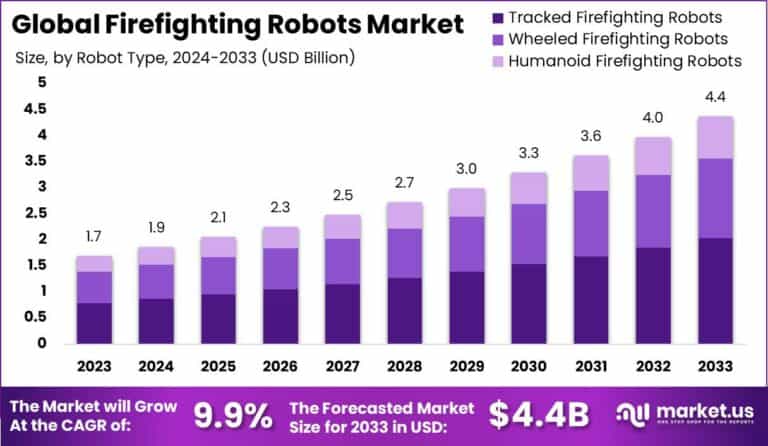Table of Contents
Introduction
The Global Firefighting Robots Market is witnessing strong growth, driven by increasing demand for advanced firefighting solutions and rising safety concerns. In 2023, the market reached USD 1.7 billion and is projected to grow to USD 4.4 billion by 2033, expanding at a CAGR of 9.90%. North America dominated the market with over 37.0% share, generating USD 0.6 billion in revenue. Technological advancements, growing urban infrastructure, and the need for effective disaster response are propelling the adoption of firefighting robots globally, transforming traditional fire suppression methods.

How Growth is Impacting the Economy
The growth of the firefighting robots market is positively impacting the global economy by fostering innovation in robotics, AI, and emergency response sectors. Rising investments stimulate research in autonomous navigation, sensor technology, and remote-controlled systems. The market creates high-skilled job opportunities in engineering, manufacturing, and software development, contributing to technological workforce expansion.
Governments benefit from enhanced disaster preparedness, reducing financial losses from fire-related incidents. Insurance sectors see reduced claims due to improved fire mitigation capabilities. Startups and SMEs entering the market promote entrepreneurship, while large corporations diversify their portfolios, fueling cross-industry collaborations that strengthen the broader technology ecosystem.
➤ To Elevate Your Business – Request Sample Here @ https://market.us/report/firefighting-robots-market/free-sample/
Impact on Global Businesses
Rising Costs & Supply Chain Shifts
Businesses face increasing costs related to R&D, sensor integration, and advanced software development for autonomous systems. Supply chains are evolving, with companies seeking specialized component suppliers for durable, heat-resistant materials and high-precision electronics, often sourcing from Asia-Pacific manufacturing hubs.
Sector-Specific Impacts
Emergency response agencies benefit from improved firefighter safety and operational efficiency. Construction and oil & gas industries adopt firefighting robots for high-risk environments. Defense sectors integrate these robots for specialized military applications. Insurance companies promote their use to minimize large-scale fire damages, enhancing risk management strategies.
Strategies for Businesses
Businesses should focus on integrating AI-powered navigation, real-time data analytics, and advanced sensor systems to enhance robot autonomy and effectiveness. Strategic partnerships with public safety agencies and industrial sectors can expand deployment opportunities. Investing in modular designs allows customization for various fire scenarios. Continuous compliance with safety standards and government certifications will strengthen market credibility. Offering comprehensive training and maintenance services creates additional revenue streams.
Key Takeaways
- Global market to grow at 9.90% CAGR by 2033.
- North America leads with 37.0% share, generating USD 0.6 billion.
- AI, robotics, and autonomous navigation drive growth.
- Rising industrial demand for high-risk firefighting applications.
- Public-private collaborations foster market expansion.
➤ Quick Purchase Full Report Here @ https://market.us/purchase-report/?report_id=134612
Analyst Viewpoint
The firefighting robots market is transitioning from niche deployments to mainstream adoption as technology matures and safety regulations tighten. Currently, robotic solutions provide invaluable support in hazardous environments, reducing human risk. In the coming years, advancements in autonomous decision-making, multi-robot coordination, and drone integration will further enhance efficiency. As urbanization and industrialization intensify globally, the market holds significant long-term growth potential, driven by safety priorities, innovation, and government support.
Regional Analysis
North America dominates with a 37.0% share, generating USD 0.6 billion in 2023, supported by advanced public safety infrastructure and strong government investments in emergency technologies. Europe follows with increasing adoption due to stringent safety regulations and modernization of firefighting fleets. Asia-Pacific experiences rapid growth driven by industrial expansion, urban development, and growing disaster preparedness initiatives. Latin America and the Middle East & Africa show emerging potential with rising urbanization and infrastructure investments.
Business Opportunities
Significant opportunities lie in AI-powered autonomous robots for urban firefighting, industrial disaster management, and defense applications. Developing lightweight, heat-resistant materials and modular designs presents new avenues for innovation. Governments worldwide seek advanced robotic solutions to strengthen national emergency response capabilities. Private sector partnerships with industrial facilities, airports, and petrochemical plants create long-term service contracts. Customized solutions for unique fire scenarios offer niche market expansion.
Key Segmentation
The firefighting robots market is segmented into:
Robot Type
- Humanoid Robots
- Wheeled Robots
- Tracked Robots
- Others
Operation
- Autonomous
- Remote-Controlled
Application
- Commercial
- Industrial
- Residential
- Defense & Military
- Others
End-User
- Fire Departments
- Industrial Facilities
- Defense Organizations
- Airports & Ports
- Energy Sector
Region
- North America
- Europe
- Asia Pacific
- Middle East & Africa
- Latin America
Key Player Analysis
Leading companies focus on enhancing AI-driven navigation, integrating real-time heat mapping, and expanding multi-sensor capabilities for complex fire scenarios. Continuous investment in R&D fuels innovations in mobility, battery performance, and thermal resistance. Partnerships with emergency agencies, defense organizations, and industrial sectors strengthen market presence. Developing scalable solutions for both public sector contracts and private industrial clients ensures sustainable growth. Offering training, simulation, and after-sales support services helps maintain long-term customer relationships.
- Mitsubishi Heavy Industries, Ltd.
- Howe & Howe Technologies
- DOK-ING
- Shark Robotics
- HOPE Technik
- EmiControls
- LeoTronics Robotics
- Angatec
- Milrem AS
- Vimal Fire Controls Pvt. Ltd.
- Other Key Players
Recent Developments
- In 2023, advanced AI algorithms for autonomous obstacle navigation were integrated into leading firefighting robot platforms.
- Partnerships with industrial giants expanded robot deployment in oil, gas, and chemical plants.
- New heat-resistant material technologies were introduced to improve operational durability.
- Governments launched pilot programs for urban firefighting robot deployments in high-density areas.
- Drone-integrated firefighting robot systems were developed for enhanced situational awareness.
Conclusion
The Global Firefighting Robots Market is transforming emergency response through advanced technology, improving safety, and operational effectiveness. As AI, robotics, and autonomous systems evolve, the sector offers substantial growth opportunities, reshaping firefighting strategies worldwide while minimizing human risk in hazardous environments.
Discuss your needs with our analyst
Please share your requirements with more details so our analyst can check if they can solve your problem(s)



